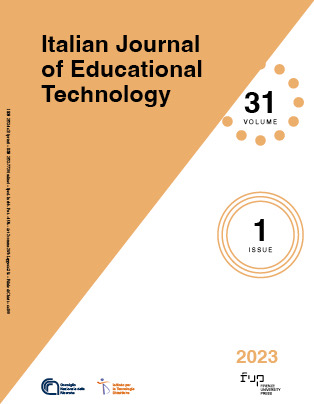EDITORIAL. CHILDREN'S LEARNING WITH DIGITAL TECHNOLOGIES
Main Article Content
Abstract
This issue includes a dossier about children’s learning with digital technologies, focussing in particular on early childhood (EC) education. ICTs are ubiquitous in the environment around children, and they are exposed to technologies in different contexts and ways; for this reason, concerns have been raised by parents and educators on their impact on children’s health and development and the use of ICT in early childhood education has attracted a great deal of attention of different stakeholders, at educational and policy level. The use of ICT in children education, especially in EC, has been debated (Plowman & Stephen, 2003) due, indeed, to their potentially detrimental effects on children’s cognitive, physical, social, and emotional development. Although concerns cannot be disregarded, the view that has prevailed over the years is that ICTs can usefully support children education provided that they are used appropriately.
A significant contribution to the field was yielded by the literature review commissioned in 2004 by the Ministry of Education of New Zealand (Bolstad, 2004), that concluded that ICT use can provide a context for collaboration, cooperation, and positive learning experiences between children, or between children and adults, as long as educators are well-aware of the kind of interaction they want to stimulate and adopt suitable pedagogical strategies to support them. An important principle expressed in the same years is that of developmental appropriateness (Siraj-Blatchford & Whitebread, 2003), which resulted in a framework based on nine general criteria to guide both teachers and decision-makers in the identification and application of the most appropriate ICT tools for EC education.
Another seminal work is the UNESCO report (2010) on ICT potential in EC education, analysing state of the art research in the field. The report highlights the capability of ICT to support some of the fundamental areas of development that should be stimulated during the preschool period (creativity, learning to learn, linguistic and mathematical skills, etc.). Besides the above-mentioned advantages, the report focuses also on the role of educators in the identification of the appropriate ICT resources and the pedagogical implications of their use. The trait d’union of these works reside not just in focusing the attention on the appropriateness of the technologies for the specific context but also on the pedagogical implications of technology integration in the curriculum and on the importance of educators’ and teachers’ professional development.
In 2015, Kerckaert and colleagues commented that, despite the open debate, research on the use of ICT in early childhood education was still in its infancy (Kerckaert, Vanderlinde, & van Braak, 2015); currently, as editors of this issue, we can observe that the call has attracted a limited number of contributions, this is perhaps indicative of the fact that, although some progress has been made, research in this specific area is not as far-reaching as in others.
This dossier stems from the efforts within the Animated Learning for Transitions - Early Recognition 2.0 (Alt-Er 2.0) Erasmus+ project (https://earlyeducationgame.com) to stimulate the reflection on the use of ICTs and creative strategies to help children in their learning and development and includes three papers that deal with different aspects of ICT adoption. [...]
Article Details
Authors who publish with this journal agree to the following terms:
- Authors retain copyright and grant the journal right of first publication with the work simultaneously licensed under a Creative Commons CC BY 4.0 Attribution 4.0 International License.
- Authors are able to enter into separate, additional contractual arrangements for the non-exclusive distribution of the journal's published version of the work (e.g., post it to an institutional repository or publish it in a book), with an acknowledgement of its initial publication in this journal.
- Authors are permitted and encouraged to post their work online (e.g., in institutional repositories or on their website) prior to and during the submission process, as it can lead to productive exchanges, as well as earlier and greater citation of published work (See The Effect of Open Access)
References
Kerckaert, S., Vanderlinde, R., & van Braak, J. (2015). The role of ICT in early childhood education: Scale development and research on ICT use and influencing factors. European Early Childhood Education Research Journal, 23(2), 183–199. doi:10.1080/1350293X.2015.1016804
Siraj-Blatchford, J., & Whitebread, D. (2003). Supporting Information and Communication Technology in the Early Years. Maidenhead, Berkshire, UK: Open University Press
Plowman, L., & Stephen, C. (2003). A “Benign Addition”? Research on ICT and Pre-School Children. Journal of Computer Assisted Learning, 19, 149-164. doi: 10.1046/j.0266-4909.2003.00016.x
UNESCO. (2010). Recognizing the potential of ICT in early childhood education: analytical survey. Retrieved from https://unesdoc.unesco.org/ark:/48223/pf0000190433

